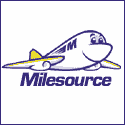Airbus A380 Completes Historic 1st Flight
Wednesday April 27, 4:26 PM ET
By
LAURENCE FROST, AP Business Writer
BLAGNAC, France
- Cheered
by tens of thousands of onlookers, the world's largest jetliner touched
down Wednesday with puffs of smoke from its 22 outsize wheels, ending
the historic maiden flight for a plane that Airbus hopes will carry it
to market dominance.
The
A380's four-hour sortie past the
snowcapped Pyrenees removed any doubt that the behemoth capable of
carrying as many as 840 passengers is airworthy. But it did little to
convince skeptics, led by U.S. rival Boeing Co., that the plane will
prove profitable.
About
30,000 people watched the takeoff and
landing, police said, many from just outside the airport perimeter,
where whole families spent the night awaiting European aviation's
biggest spectacle since the supersonic Concorde's first flight in 1969.
Applause
reverberated across the airfield
and adjacent Airbus headquarters in this town outside the southwestern
city of Toulouse as test pilots Claude Lelaie and Jacques Rosay emerged
from the big white plane with a blue tail, waving happily, with their
four fellow crew members.
Flying
the plane was as easy as "riding a
bicycle," Rosay said. Engineer Fernando Alonso said the crew enjoyed an
"extremely comfortable" flight.
"Now
shareholders can sleep better at
night," chief flight engineer Gerard Desbois added.
But
the hats stayed on in Seattle, home to
a sizable part of Boeing's operations. The
superjumbo is "a very large
airplane for a very small market," Boeing spokesman Jim Condelles said.
"First
flights are always very interesting
and exciting. It's an engineering accomplishment that Airbus should be
very proud of," he said. "We just don't see a market for 1,250 of these
airplanes over the next 20 years."
Condelles
was referring to Airbus' global
market forecast for very large jets. Boeing sees demand for just 400
jets with 450 seats or more. If Airbus is right, it could enjoy a
near-monopoly in that market while Boeing scrambles to produce a
competitor.
But
some industry experts think Airbus
— which is almost certain to outsell Boeing for a second
straight year in 2005 — is more likely to end up with egg on
its face after spending $13 billion over 11 years developing the A380.
"Airbus
is being incredibly optimistic,"
said Frank Werner, an airline management specialist at Fordham
University's business school in New York. "I don't think they're going
to sell enough planes in a short enough time to make it financially
viable."
Airbus
has orders for 154 superjumbos and
has said it needs 100 more to recover its investment. But the weak
dollar — the currency in which passenger planes are sold
— and rumors of heavy discounts on the A380's $282 million
sticker price have fueled reports that the real break-even may be
higher.
There
are also fears that sales could
suffer from decisions by big airports like Atlanta not to strengthen
runways and put in the bigger boarding gates needed to handle the A380.
But others — including San Francisco and New York —
are preparing for the huge plane, and Werner said he expected holdouts
to follow suit when airlines begin flying the superjumbo in mid-2006.
Airbus
critics also say its focus on the
A380 has led it to neglect the mid-size plane market, where its planned
A350 is set to enter service in 2010 — two years after
Boeing's 787 "Dreamliner." Airlines have ordered 237 787s so far.
Airbus
CEO Noel Forgeard plays down the
787's development lead, saying the battle for the market in smaller
planes will be fought over 20 years, not two. On Wednesday, he called
the A380's development a "fantastic collective effort."
Shares
in European Aeronautic Defence and
Space Co., which owns 80 percent of Airbus, closed 2.4 percent lower
Wednesday at $28.48 a share. Britain's BAE Systems PLC, which owns the
rest, closed down 0.6 percent at $4.81.
Whatever
the criticism, the A380 launch was
a major advertisement for Airbus' technological prowess and an emblem
for its new status as the world's largest aircraft maker.
The
jet carried 22 tons of test instruments
plus extra ballast to increase its total takeoff weight to 464 tons, or
about 75 percent of its maximum authorized takeoff weight for
commercial flights — but already a new record for a civil
airliner. The crew plans to gradually increase the ballast over a
further 2,500 hours of airborne tests.
While
the plane has the capability of
carrying 840 passengers, airlines are planning seating configurations
that will limit loads to about 550 people.
In an
impromptu fly-by at Blagnac at the
end of the test, the A380 passed over the runway at low speed, flaps
extended, before banking confidently around for its final approach.
"It's
magnificent," said Jean Begue, who
worked as an industrial director on the early stages of the A380
program.
___
Associated
Press writers John Leicester in
Paris and Perrine Latrasse in Blagnac contributed to this report.
The
Associated Press contributed to this report.
Copyright
© 2005
The Associated Press. All rights reserved. The
information contained in the AP News report may not be published,
broadcast, rewritten or redistributed without the prior written
authority of The Associated Press.
AviationHistory.org shall not be liable for any errors or delays in the
content, or for any actions taken in reliance thereon.
|















